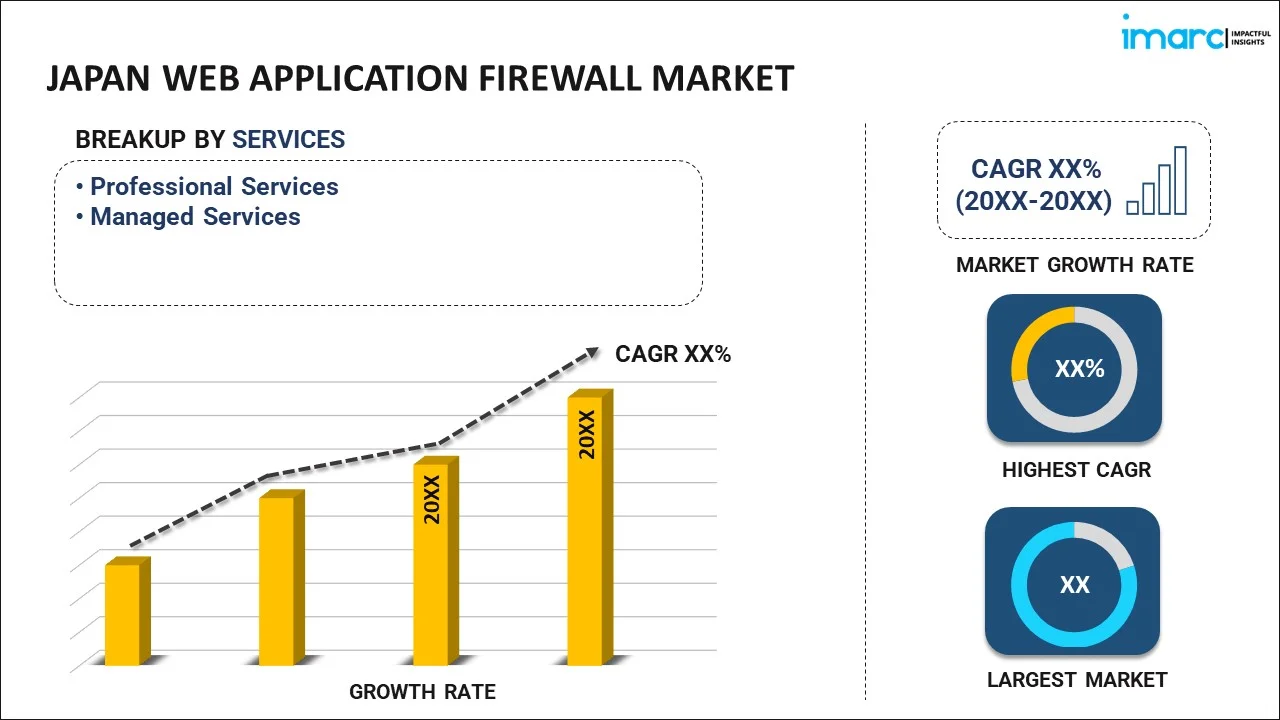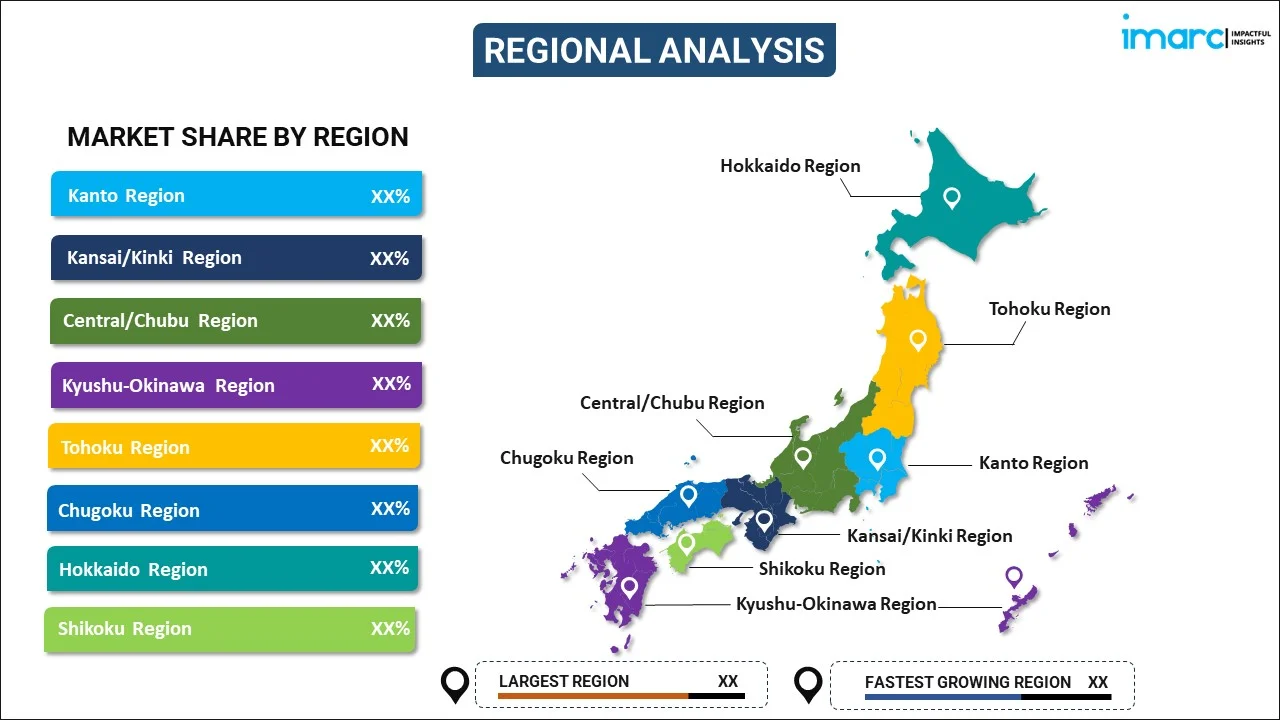
Japan Web Application Firewall Market Report by Service (Professional Services, Managed Services), Deployment (Cloud-based, On-premises), Organization Size (Large Enterprises, Small and Medium-sized Enterprises), End Use Industry (Government and Defense, BFSI, Retail, Healthcare, IT and Telecom, Energy and Utilities, Manufacturing, and Others), and Region 2025-2033
Market Overview:
Japan web application firewall market size reached USD 367.0 Million in 2024. Looking forward, IMARC Group expects the market to reach USD 1,702.0 Million by 2033, exhibiting a growth rate (CAGR) of 18.6% during 2025-2033. The rising number and sophistication of cyberattacks, including web application attacks like SQL injection and cross-site scripting (XSS), coupled with the increasing demand for web application firewall solutions to protect their web applications from these threats, is driving the market.
|
Report Attribute
|
Key Statistics
|
|---|---|
|
Base Year
|
2024
|
|
Forecast Years
|
2025-2033
|
|
Historical Years
|
2019-2024
|
|
Market Size in 2024
|
USD 367.0 Million |
|
Market Forecast in 2033
|
USD 1,702.0 Million |
| Market Growth Rate 2025-2033 | 18.6% |
A web application firewall (WAF) is a security solution designed to protect web applications from a variety of online threats. It acts as a barrier between a web application and the internet, monitoring and filtering incoming traffic to identify and block potentially harmful requests. WAFs analyze the data exchanged between users and the web application, searching for suspicious patterns or known attack signatures, such as SQL injection, cross-site scripting (XSS), and more. When a potential threat is detected, the WAF can block or filter the malicious traffic, preventing it from reaching the application and potentially compromising its security. WAFs are essential for safeguarding web applications against cyberattacks and helping to maintain data confidentiality, integrity, and availability. They provide an additional layer of defense beyond traditional network firewalls. They are a critical component of web security strategies for organizations looking to protect their online assets from evolving cyber threats.
Japan Web Application Firewall Market Trends:
The web application firewall market in Japan is experiencing robust growth due to several key drivers. Firstly, the escalating frequency and sophistication of cyberattacks, coupled with the increasing reliance on web-based applications, have made cybersecurity a top priority for organizations. Consequently, businesses are investing heavily in WAF solutions to fortify their digital infrastructure against malicious threats. Moreover, the growing adoption of cloud-based services and the rapid expansion of e-commerce have amplified the need for WAFs. As organizations migrate their applications and data to the cloud, they seek WAFs capable of securing these distributed environments effectively. This trend has led to a surge in demand for cloud-native and multi-cloud compatible WAF solutions. Additionally, stringent regulatory compliance requirements have mandated enhanced data protection measures. To meet these regulations, businesses are turning to WAFs to safeguard sensitive customer information and maintain regulatory compliance. Furthermore, the proliferation of IoT devices and the emergence of edge computing, which have widened the attack surface, is expected to drive the web application firewall market in Japan during the forecast period.
Japan Web Application Firewall Market Segmentation:
IMARC Group provides an analysis of the key trends in each segment of the market, along with forecasts at the country level for 2025-2033. Our report has categorized the market based on service, deployment, organization size, and end use industry.
Service Insights:

- Professional Services
- Managed Services
The report has provided a detailed breakup and analysis of the market based on the service. This includes professional services and managed services.
Deployment Insights:
- Cloud-based
- On-premises
A detailed breakup and analysis of the market based on the deployment have also been provided in the report. This includes cloud-based and on-premises.
Organization Size Insights:
- Large Enterprises
- Small and Medium-sized Enterprises
The report has provided a detailed breakup and analysis of the market based on the organization size. This includes large enterprises and small and medium-sized enterprises.
End Use Industry Insights:
- Government and Defense
- BFSI
- Retail
- Healthcare
- IT and Telecom
- Energy and Utilities
- Manufacturing
- Others
A detailed breakup and analysis of the market based on the end use industry have also been provided in the report. This includes government and defense, BFSI, retail, healthcare, IT and telecom, energy and utilities, manufacturing, and others.
Regional Insights:

- Kanto Region
- Kansai/Kinki Region
- Central/ Chubu Region
- Kyushu-Okinawa Region
- Tohoku Region
- Chugoku Region
- Hokkaido Region
- Shikoku Region
The report has also provided a comprehensive analysis of all the major regional markets, which include Kanto Region, Kansai/Kinki Region, Central/ Chubu Region, Kyushu-Okinawa Region, Tohoku Region, Chugoku Region, Hokkaido Region, and Shikoku Region.
Competitive Landscape:
The market research report has also provided a comprehensive analysis of the competitive landscape in the market. Competitive analysis such as market structure, key player positioning, top winning strategies, competitive dashboard, and company evaluation quadrant has been covered in the report. Also, detailed profiles of all major companies have been provided.
Japan Web Application Firewall Market Report Coverage:
| Report Features | Details |
|---|---|
| Base Year of the Analysis | 2024 |
| Historical Period | 2019-2024 |
| Forecast Period | 2025-2033 |
| Units | Million USD |
| Scope of the Report | Exploration of Historical Trends and Market Outlook, Industry Catalysts and Challenges, Segment-Wise Historical and Future Market Assessment:
|
| Services Covered | Professional Services, Managed Services |
| Deployments Covered | Cloud-based, On-premises |
| Organization Sizes Covered | Large Enterprises, Small and Medium-sized Enterprises |
| End Use Industries Covered | Government and Defense, BFSI, Retail, Healthcare, IT and Telecom, Energy and Utilities, Manufacturing, Others |
| Regions Covered | Kanto Region, Kansai/Kinki Region, Central/ Chubu Region, Kyushu-Okinawa Region, Tohoku Region, Chugoku Region, Hokkaido Region, Shikoku Region |
| Customization Scope | 10% Free Customization |
| Post-Sale Analyst Support | 10-12 Weeks |
| Delivery Format | PDF and Excel through Email (We can also provide the editable version of the report in PPT/Word format on special request) |
Key Questions Answered in This Report:
- How has the Japan web application firewall market performed so far and how will it perform in the coming years?
- What has been the impact of COVID-19 on the Japan web application firewall market?
- What is the breakup of the Japan web application firewall market on the basis of service?
- What is the breakup of the Japan web application firewall market on the basis of deployment?
- What is the breakup of the Japan web application firewall market on the basis of organization size?
- What is the breakup of the Japan web application firewall market on the basis of end use industry?
- What are the various stages in the value chain of the Japan web application firewall market?
- What are the key driving factors and challenges in the Japan web application firewall?
- What is the structure of the Japan web application firewall market and who are the key players?
- What is the degree of competition in the Japan web application firewall market?
Key Benefits for Stakeholders:
- IMARC’s industry report offers a comprehensive quantitative analysis of various market segments, historical and current market trends, market forecasts, and dynamics of the Japan web application firewall market from 2019-2033.
- The research report provides the latest information on the market drivers, challenges, and opportunities in the Japan web application firewall market.
- Porter's five forces analysis assist stakeholders in assessing the impact of new entrants, competitive rivalry, supplier power, buyer power, and the threat of substitution. It helps stakeholders to analyze the level of competition within the Japan web application firewall industry and its attractiveness.
- Competitive landscape allows stakeholders to understand their competitive environment and provides an insight into the current positions of key players in the market.
Need more help?
- Speak to our experienced analysts for insights on the current market scenarios.
- Include additional segments and countries to customize the report as per your requirement.
- Gain an unparalleled competitive advantage in your domain by understanding how to utilize the report and positively impacting your operations and revenue.
- For further assistance, please connect with our analysts.
 Inquire Before Buying
Inquire Before Buying
 Speak to an Analyst
Speak to an Analyst
 Request Brochure
Request Brochure
 Request Customization
Request Customization




.webp)




.webp)












